

Charles Darwin. Charles Robert Darwin, FRS (/ˈdɑrwɪn/;[1] 12 February 1809 – 19 April 1882) was an English naturalist and geologist,[2] best known for his contributions to evolutionary theory.
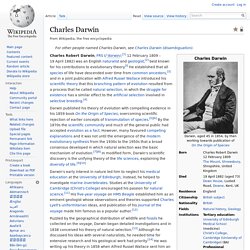
[I] He established that all species of life have descended over time from common ancestors,[3] and in a joint publication with Alfred Russel Wallace introduced his scientific theory that this branching pattern of evolution resulted from a process that he called natural selection, in which the struggle for existence has a similar effect to the artificial selection involved in selective breeding.[4] Gregor Mendel. The profound significance of Mendel's work was not recognized until the turn of the 20th century (more than three decades later) with the independent rediscovery of these laws.[4] Erich von Tschermak, Hugo de Vries, Carl Correns, and William Jasper Spillman independently verified several of Mendel's experimental findings, ushering in the modern age of genetics.
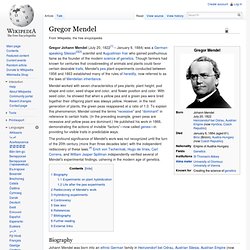
Biography When Mendel entered the Faculty of Philosophy, the Department of Natural History and Agriculture was headed by Johann Karl Nestler who conducted extensive research of hereditary traits of plants and animals, especially sheep. Upon recommendation of his physics teacher Friedrich Franz,[8] Mendel entered the Augustinian St Thomas's Abbey and began his training as a priest. Born Johann Mendel, he took the name Gregor upon entering religious life. Mendel worked as a substitute high school teacher. Mendel began his studies on heredity using mice. Experiments on plant hybridization Life after the pea experiments Controversy. Friedrich Miescher. Johannes Friedrich Miescher (13 August 1844 – 26 August 1895) was a Swiss physician and biologist.
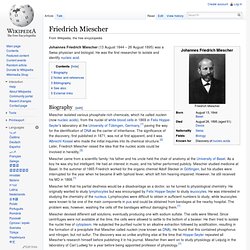
He was the first researcher to isolate and identify nucleic acid. Albrecht Kossel. Kossel isolated and described the five organic compounds that are present in nucleic acid: adenine, cytosine, guanine, thymine, and uracil.

These compounds were later shown to be nucleobases, and are key in the formation of DNA and RNA, the genetic material found in all living cells. James D. Watson. James Dewey Watson, KBE (hon.), ForMemRS, (born April 6, 1928) is an American molecular biologist, geneticist and zoologist, best known as a co-discoverer of the structure of DNA in 1953 with Francis Crick.
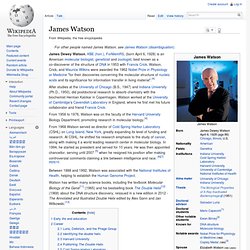
Watson, Crick, and Maurice Wilkins were awarded the 1962 Nobel Prize in Physiology or Medicine "for their discoveries concerning the molecular structure of nucleic acids and its significance for information transfer in living material".[4] After studies at the University of Chicago (B.S., 1947) and Indiana University (Ph.D., 1950), did postdoctoral research to absorb chemistry with the biochemist Herman Kalckar in Copenhagen, Watson worked at the University of Cambridge's Cavendish Laboratory in England, where he first met his future collaborator and friend Francis Crick. Francis Crick. During the remainder of his career, he held the post of J.W.
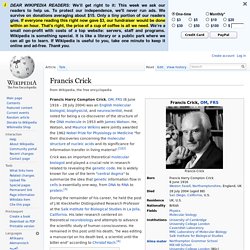
Kieckhefer Distinguished Research Professor at the Salk Institute for Biological Studies in La Jolla, California. His later research centered on theoretical neurobiology and attempts to advance the scientific study of human consciousness. He remained in this post until his death; "he was editing a manuscript on his death bed, a scientist until the bitter end" according to Christof Koch.[4] Rosalind Franklin. Rosalind Elsie Franklin (25 July 1920 – 16 April 1958)[1] was a British biophysicist and X-ray crystallographer who made critical contributions to the understanding of the fine molecular structures of DNA (deoxyribonucleic acid), RNA, viruses, coal, and graphite.[2] Her DNA work achieved the most fame because DNA plays an essential role in cell metabolism and genetics, and the discovery of its structure helped her co-workers understand how genetic information is passed from parents to their offspring.

Franklin is best known for her work on the X-ray diffraction images of DNA which led to the discovery of the DNA double helix. According to Francis Crick, her data was key to determining the structure[3] to formulate Crick and Watson's 1953 model regarding the structure of DNA.[4] Franklin's images of X-ray diffraction confirming the helical structure of DNA were shown to Watson without her approval or knowledge. Maurice Wilkins. Maurice Hugh Frederick Wilkins CBE FRS (15 December 1916 – 5 October 2004)[1] was a New Zealand-born English physicist and molecular biologist, and Nobel Laureate whose research contributed to the scientific understanding of phosphorescence, isotope separation, optical microscopy and X-ray diffraction, and to the development of radar.

He is best known for his work at King's College London on the structure of DNA which falls into three distinct phases. The first was in 1948-50 where his initial studies produced the first clear X-ray images of DNA which he presented at a conference in Naples in 1951 attended by James Watson. In 1953 Franklin instructed Raymond Gosling to give Wilkins, without condition, a high quality image of "B" form DNA which she had unexpectedly produced months earlier [5] but had “put it aside” [6] to concentrate on other work. Wilkins, having checked he was free to use the photograph to confirm his earlier results [7] showed it to Watson. DNA 5of5 Pandoras Box. DNA 4of5 Curing Cancer. DNA 3of5 The Human Race. DNA 2of5 Playing God. DNA 1of5 The Secret of Life.